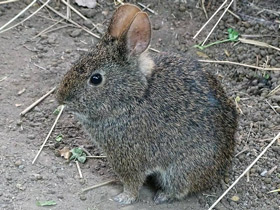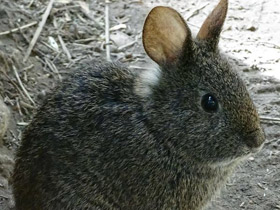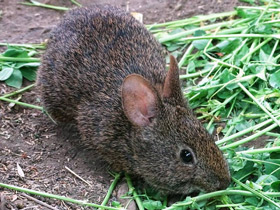The volcano rabbit (Romerolagus diazi), teporingo or zacatuche
Distinguishing features
The volcano rabbit (Romerolagus diazi), also known as teporingo or zacatuche, is an incredibly cute little creature. Its body length varies from 27 to 32 cm and weight from 400 to 600 g. It is one of the smallest representatives of the family. Its fur is greyish-brown, its ears are short and round, 4-4.5 cm long, and its tail is so small that it is not visible from the outside. The hind limbs of Romerolagus diazi are relatively short. The hair cover is soft and rather dense. Its colouration on the back is greyish-brown and black with an admixture of yellow hairs. On the belly it is ashy-grey, with a dirty yellow tinge. The species name was given in honour of Augustin Diaz (1829-1893).
Habitat
Romerolagus diazi are distributed in Mexico only in the upper and middle levels of the slopes of the Istaxihuatl and Popocatepetl volcanoes, and on the slopes of the Pares and Ajusco mountains. Their entire range is approximately 40 kilometres in length. They live in mountain light pine forests near their upper limit at 3000-3600 metres above sea level. Most often rabbits keep in thickets of dense grass. These animals are active mainly at dusk, spending the rest of the time in their burrows, which are up to 5 m long and have several exits. Often a common burrow is shared by 2 to 5 animals. Tailless rabbits communicate with each other by making high squeaking sounds resembling the voice of pika, as well as drumming with their hind legs. They feed on young grass shoots.
Breeding
Romerolagus diazi can produce cubs throughout the year, but births peak in the rainy summer. The gestation period is 38-40 days, with a litter of 1 to 5 (2 on average) cubs. They spend the first weeks of life in a burrow, but after 3 weeks they take solid food and become independent at the age of one month.
Diet
The volcano rabbit feeds primarily on grasses such as Festuca amplissima, Muhlenbergia macroura, Stipa ichu, and Eryngium rosei. The rabbits also use these plants as cover to hide from predators. M. macroura was found to be in 89% of pellets of the volcano rabbits, suggesting that this is the base of their diet, but it does not actually provide the necessary energy and protein needs of the rabbits. Supplementing their diet with 15 other forms of plant life, volcano rabbits can get their required nutrition. Other plant species that also are responsible for supporting the volcano rabbit are the Muhlenbergia quadidentata, the Pinus hartwegii, F. tolucensis, P. hartwegeii. Volcano rabbits also consume leaves, foliage, and flowers indiscriminately under poor conditions, as habitat loss has eliminated much of their food sources. In fact, protein acquisition is the primary limiting factor on the size of the populations of each of the four volcanoes on which the species is located. Studies show that many individuals of the population suffer from serious weight loss and starvation.
Seasonal changes also affect the diet of the volcano rabbit greatly. The grasses it normally consumes are abundant during wet seasons. During the dry season, the volcano rabbit feasts on shrubs and small trees, as well as other woody plants. During the winter plants, these woody plants make up most of their diet, as well as the primary building material for their nests.
Conservation status
Although the species is protected in Mexico, it is still occasionally hunted. However, the main threat is the uprooting of the forest for fields and pastures. Today, the species' distribution area is divided into 3 small patches. The exact number of the volcano rabbit cannot be determined, its estimates range from 3 to 12 thousand animals. Romerolagus diazi is listed on the IUCN Red List of Threatened Species.















































